
GINZA CONNECTIVE
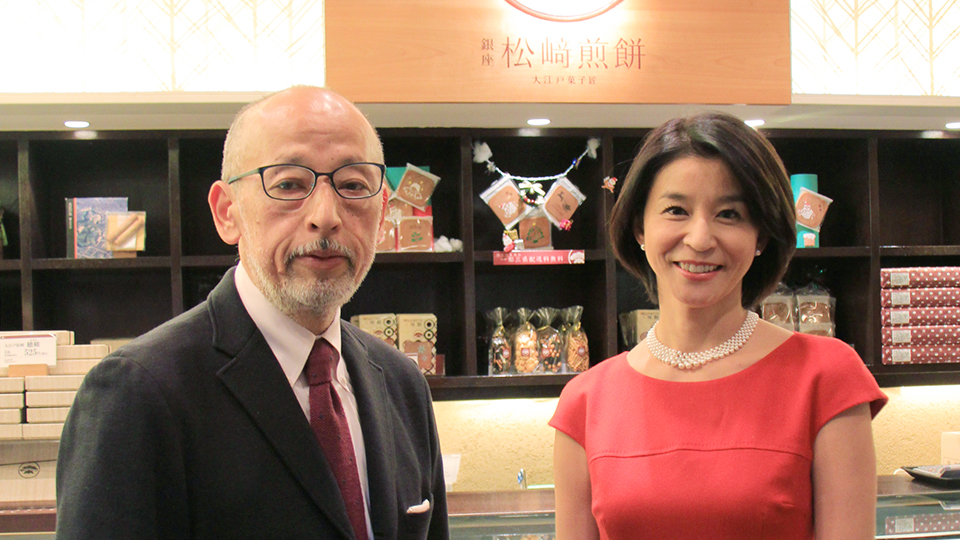
GINZA CONNECTIVE VOL.28
Munehito Matsuzaki×Chisako Takashima
2014.01.01
A talk series with the violinist Chisako Takashima and the Ginza people. Ginza holds many personal and professional memories for Takashima. In this talk series, she thoroughly explores various aspects of the Ginza culture with her guests. Today’s guest is Munehito Matsuzaki, the president of Ginza Matsuzaki Senbei t hat has a long history going back to the Edo period.
Veteran sembei shop of over 200 years that boasts one of the longest histories in Ginza.
- Takashima
- I was amazed to hear that your shop opened in the first year of the Bunka era! It has a history of over 200 years.
- Matsuzaki
- That’s right. It opened in 1804. It first started in the Mikawa Province in the Kansai area and then a shop was opened in Shiba in Tokyo. It remained there for three generations before moving to Ginza in 1865.
- Takashima
- So, it also has a particularly long history among veteran shops in Ginza.
- Matsuzaki
- Yes, from the Edo period, so it is quite old. I am the seventh president, and my son will be the eighth.
- Takashima
- Was it always a sembei (cracker) shop?
- Matsuzaki
- Yes. We now also have a sweets parlor and a gallery, but we have always had sembei. Our sembei is actually kawara-sembei (tile shaped crackers), because our roots are in Kansai. They’re very different from the Kanto style sembei that is hard and soy sauce flavored.
- Takashima
- Really?? I did not know there was a difference between Kanto and Kansai sembei. I was looking at the products in the storefront. They have lots of cute pictures on them and are fun to look at.
- Matsuzaki
- Thank you. We make “shamido” crackers that are our original brand of kawara-sembei. These pictures are drawn on with syrup. The fourth president of the shop started this because he said he wanted to add a seasonal touch.
- Takashima
- What is in them?
- Matsuzaki
- Just flour, sugar and eggs. They are then poured into a mold. A characteristic of our shop is that we try to simulate baking by hand as closely as possible and bake them very carefully. They have no butter in them, so the flavor is very simple.
- Takashima
- Kawara-sembei with a simple and wonderful sweet flavor — sounds wonderful. Do you sell other products than sembei?
- Matsuzaki
- We also sell some Japanese-style sweets. Today I have brought out for you a traditional Yamagata sweet that we sell from the end of the year until the beginning of January. These are sugar-preserved eggplant sweets, so people either love them or hate them. It’s a rare sweet, so please give it a try.
- Takashima
- Oh, thank you! This is the first time for me to try an eggplant sweet.
- Matsuzaki
- As the saying goes, ‘‘First, Mt. Fuji; second, hawks; third, eggplants,” so eggplant sweets are favored around New Years as a bringer of good luck.
- Takashima
- (Takes a bite) Delicious! Preserving it in sugar makes it taste like a fruit. I love it. Thank you for such a special treat.
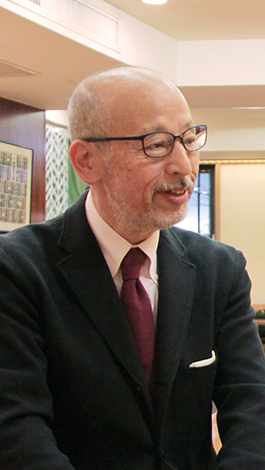
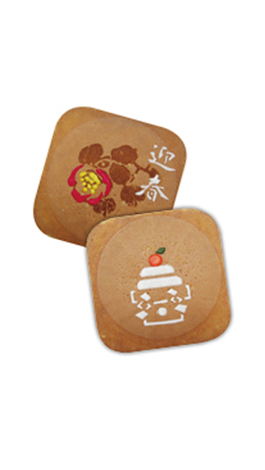
original kawara-sembei: Shamido
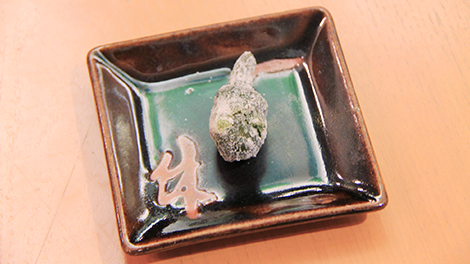
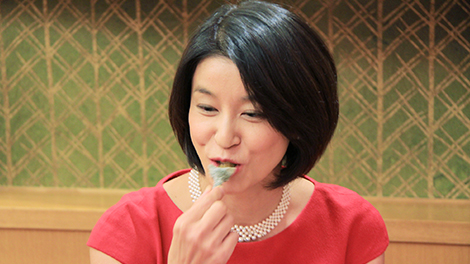
Chisako Takashima eating “Yume,” a sugar-preserved eggplant sweet that is a limited-time product
I was born and raised in Ginza. I remember playing catch on Namiki-dori when I was young.
- Takashima
- Were you born in Ginza?
- Matsuzaki
- Yes, I was born in Ginza. My mother, son and daughter were also born in Ginza.
- Takashima
- That’s so cool! So you have been watching it change and grow since long ago.
- Matsuzaki
- Yes. I lived in Ginza until my 30’s, so I have watched it change over the years. When my mother was a little girl, the famous Daikokuya bag shop was still a dry food grocer’s. If there wasn’t anything to go with rice for dinner, my grandfather would send her grocery shopping there and give her some extra money to buy herself a treat. That was the atmosphere of downtown Tokyo at the time. The area around Namiki-dori at 4-Chome was not so bustling, so we played catch there the first three days of the new year.
- Takashima
- Wow! That is hard to believe now!
- Matsuzaki
- Until after I turned thirty, the Yomiuri Shimbun newspaper building was where Printemps is now, and the Asahi Shimbun newspaper building was where the Marion is now. This area was filled not with boutiques and restaurants, but with office buildings, mahjong halls, red paper lantern diners and cafes, so it was relatively quiet on weekends.
- Takashima
- Now it seems completely like an area that never sleeps. I give a concert once every three months at Oji Hall and hold a closing party afterwards in Ginza. It doesn’t seem like a recession at all — in fact it’s hard to even find a parking spot. I always get the sense that Ginza is a glamorous, thriving district.
- Matsuzaki
- Yes it is. Even now, it becomes relatively quiet from around 2 in the morning, but it has changes dramatically since the olden days. That said, I think it is its acceptance of this change that gives Ginza its charm.
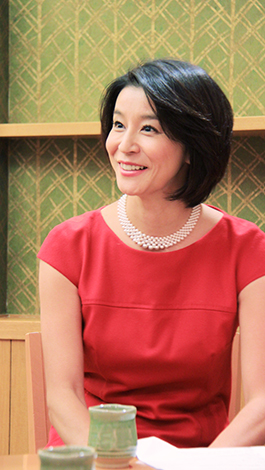
1 2
All List
- GINZA CONNECTIVE VOL.0 Ryo Sayegusa×Chisako Takashima
- GINZA CONNECTIVE VOL.1 Toshiyuki Kosaka×Chisako Takashima
- GINZA CONNECTIVE VOL.2 Yasuharu Mizuhara×Chisako Takashima
- GINZA CONNECTIVE VOL.3 Hitoshi Ishihara×Chisako Takashima
- GINZA CONNECTIVE VOL.4 Shinji Hara×Chisako Takashima
- GINZA CONNECTIVE VOL.5 Choichiro Motoyama×Chisako Takashima
- GINZA CONNECTIVE VOL.6 Noriko Okazoe×Chisako Takashima
- GINZA CONNECTIVE VOL.7 Choichiro Motoyama×Chisako Takashima
- GINZA CONNECTIVE VOL.8 Sayuri Yamaguchi×Chisako Takashima
- GINZA CONNECTIVE VOL.9 Yoshiki Tani×Chisako Takashima
- GINZA CONNECTIVE VOL.10 Yoshifumi Itoh×Chisako Takashima
- GINZA CONNECTIVE VOL.11 Kunihiko Miwa×Chisako Takashima
- GINZA CONNECTIVE VOL.12 Shin Watanabe×Chisako Takashima
- GINZA CONNECTIVE VOL.13 Akihiko Tsuda×Chisako Takashima
- GINZA CONNECTIVE VOL.14 Rie Horikawa×Chisako Takashima
- GINZA CONNECTIVE VOL.15 Jun Takahashi×Chisako Takashima
- GINZA CONNECTIVE VOL.16 Yusuke Harada×Chisako Takashima
- GINZA CONNECTIVE VOL.17 Lintaro Mizuhara×Chisako Takashima
- GINZA CONNECTIVE VOL.18 Keisuke Anzai×Chisako Takashima
- GINZA CONNECTIVE VOL.19 Hozu Yamamoto×Chisako Takashima
- GINZA CONNECTIVE VOL.20 Koji Shibata×Chisako Takashima
- GINZA CONNECTIVE VOL.21 Kayo Hosono×Chisako Takashima
- GINZA CONNECTIVE VOL.22 Mitsuru Saito×Chisako Takashima
- GINZA CONNECTIVE VOL.23 Akihisa Kawaguchi×Chisako Takashima
- GINZA CONNECTIVE VOL.24 Mamoru Sugiyama×Chisako Takashima
- GINZA CONNECTIVE VOL.25 Michiaki Kumagai×Chisako Takashima
- GINZA CONNECTIVE VOL.26 Shinichi Tanizawa×Chisako Takashima
- GINZA CONNECTIVE VOL.27 Koichi Suzuki×Chisako Takashima
- GINZA CONNECTIVE VOL.28 Munehito Matsuzaki×Chisako Takashima
- GINZA CONNECTIVE VOL.29 Hiroshi Hara × Chisako Takashima
- GINZA CONNECTIVE VOL.30 Shigeyuki Ando×Chisako Takashima
- GINZA CONNECTIVE VOL.31 Yukichi Ishikura × Chisako Takashima
- GINZA CONNECTIVE VOL.32 Seiko Yamada × Chisako Takashima
- GINZA CONNECTIVE VOL.33 Mami Nagai × Chisako Takashima
- GINZA CONNECTIVE VOL.34 Ryuta Takahashi × Chisako Takashima
- GINZA CONNECTIVE VOL.35 Kazumasa Osumi×Chisako Takashima
- GINZA CONNECTIVE VOL.36 Masahiro Kameoka×Chisako Takashima
- GINZA CONNECTIVE VOL.37 Shoichiro Watanabe×Chisako Takashima
- GINZA CONNECTIVE VOL.38 Keiji Niimoto×Chisako Takashima
- GINZA CONNECTIVE VOL.39 Chieko Nakamura ×Chisako Takashima
- GINZA CONNECTIVE VOL.40 Atsushi Yamane×Chisako Takashima
- GINZA CONNECTIVE VOL.41 Masaya Shibuya×Chisako Takashima
- GINZA CONNECTIVE VOL.42 Makoto Suzuki×Chisako Takashima
- GINZA CONNECTIVE VOL.43 Masaya Konaka×Chisako Takashima
- GINZA CONNECTIVE VOL.44 Masakazu Tanaka×Chisako Takashima
- GINZA CONNECTIVE VOL.45 Koko Kameoka × Chisako Takashima
- GINZA CONNECTIVE VOL.46 Jin Hirayama×Chisako Takashima
- GINZA CONNECTIVE VOL.47 Takashi Hoshihara×Chisako Takashima
- GINZA CONNECTIVE VOL.48 Mikiko Kimura × Chisako Takashima
- GINZA CONNECTIVE VOL.49 Keisuke Okamoto×Chisako Takashima
- GINZA CONNECTIVE VOL.50 Akira Ito × Chisako Takashima
- GINZA CONNECTIVE VOL.51 Tatsuhiko Adachi × Chisako Takashima
- GINZA CONNECTIVE VOL.52 Masahiko Yamano×Chisako Takashima
- GINZA CONNECTIVE VOL.53 Kiyoshi Kanazashi×Chisako Takashima
- GINZA CONNECTIVE VOL.54 Noriyuki Tsuji×Chisako Takashima
- GINZA CONNECTIVE VOL.55 Shoichi Kobayashi×Chisako Takashima
- GINZA CONNECTIVE VOL.56 Isao Nanjo×Chisako Takashima
- GINZA CONNECTIVE VOL.57 Shinobu Mitsuoka×Chisako Takashima
- GINZA CONNECTIVE VOL.58 Motoyoshi Yasuda×Chisako Takashima
- GINZA CONNECTIVE VOL.59 Toru Fujiki×Chisako Takashima
- GINZA CONNECTIVE VOL.60 Yuji Ida×Chisako Takashima
- GINZA CONNECTIVE VOL.61 Hitoshi Miki×Chisako Takashima
- GINZA CONNECTIVE VOL.62 Takehiko Furuya× Chisako Takashima
- GINZA CONNECTIVE VOL.63 Naoki Yoshizawa×Yusuke Yoshizawa×Chisako Takashima
- GINZA CONNECTIVE VOL.64 Kazuhito Kawase × Chisako Takashima
- GINZA CONNECTIVE VOL.65 Toshiji Yuki× Chisako Takashima
- GINZA CONNECTIVE VOL.66 Hikoyuki Yamaguchi×Chisako Takashima
- GINZA CONNECTIVE VOL.67 Daisuke Nagano×Chisako Takashima
- GINZA CONNECTIVE VOL.68 Shuichi Motohashi× Chisako Takashima
- GINZA CONNECTIVE VOL.69 Shinpei Tonaka×Chisako Takashima
- GINZA CONNECTIVE VOL.70 Shinya Kanematsu × Sachiko Takashima
- GINZA CONNECTIVE VOL.71 Masataka Yano×Chisako Takashima
- GINZA CONNECTIVE VOL.72 Mitsuhiro Kurokawa× Chisako Takashima
- GINZA CONNECTIVE VOL.73 Ryo Saegusa×Chisako Takashima








